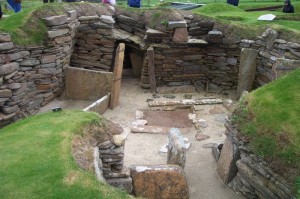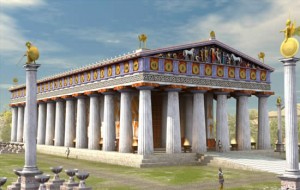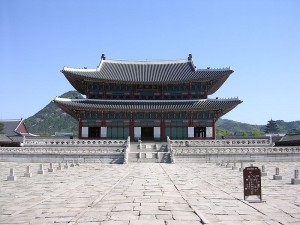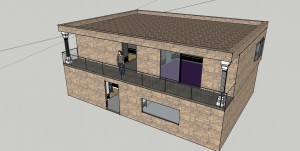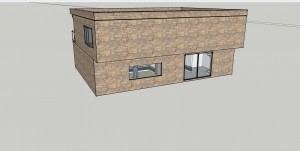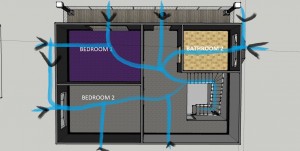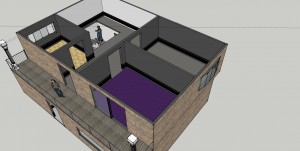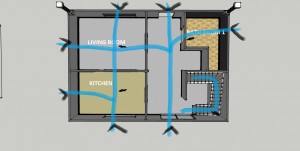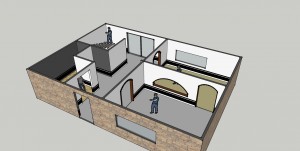- CLIMATE REGIONS
-
Climate Region 1–
Has a severe climate of mostly cool and cold temperatures that often drop far below the freezing in winter. Snow is common in most of the regions. Winter winds, which greatly add to winter discomfort usually, form northern and western directions. Since sunshine is available more than 50% of the daylight hours, solar heating is potential. Reflections of the snow can significantly increase winter sun on south facades. The summers in this climate are mild, with short hot periods. The extreme annual temperature range can reach more than 120°F. During the summer the winds are generally southerly and are an asset to achieve comfort; shading is required.
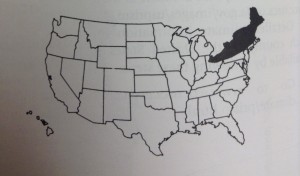 Climate Priorities:
Climate Priorities:
- Keep heat in and cold temperatures out during the winter (I)
- Protect from the cold winter winds (II)
- Let the winter sun in (III)
- Protect from the summer sun (IV)
- Use Natural ventilation for summer cooling (V)
- From Mid-September to Mid-June in this region it is considered too cold. (75%).From Mid-June through the first quarter of July and last quarter of August through the second half of September is the comfortable time period of this region (12%). And the remaining time of July and August is the “too hot” period of the year (13%).
-
Climate Region 2–
The northern plains climate is similar to region 1 but is even more severe because this region is far from the effect of the ocean. The main concern is with the winter low temperatures, which are combined with high wind speeds. Summers are very hot, its less o a concern because it is a short time period. The sun is an asset in the winter and a liability in the summer.
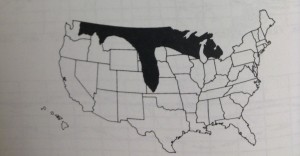 Climate Priorities
Climate Priorities
- Keep heat in and the cold temperatures out in the winter (I)
- Protect from the cold winter winds (II)
- Let the winter sun in (III)
- Use thermal mass to reduce day-to-night temperatures swing in the summer (VII)
- Protect from the summer sun (IV)
- Use Natural Ventilation for summer cooling (V)
- From September through May the region is considered to be too cold (76%) of the year. In the last quarter of June through the first quarter of August is the too hot period of the year (12%). And the rest of June and August is the comfortable periods for the body (12%).
-
Climate Region 3–
Similar to Regions 1 and 2 but somewhat more mild winter, the cold winds however is still an important concern. There is a 40% time period during daylight hours that the sun shines, so there is still some potential for solar energy.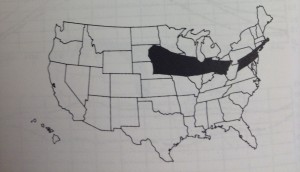
- Climate Priorities
- Keep heat in and cold temperatures out in the winter (I)
- Protect from the cold winter winds (II)
- Let the winter sun in (III)
- Keep hot temperatures out during the summer (VIII)
- Protect from the summer sun (IV)
- Use natural ventilations for summer cooling (V)
- The first third portion of September until the last third quarter of May is the too cold periods of the region (66%). Last quarter of May through half of June and last third of August through the rest of September is considered the Comfortable periods of the region (14%). Mid-June through mid-August is the too hot time frame of the region (20%)
-
Climate Region 4–
Semiarid climate with cold, windy winters and warm, dry summers. Winters are very cold, with frequent but short storms altering with sunny periods. Summer temperatures are high but the humidity is low. Thus the diurnal temperature range is high and summer nights are generally cool.
- Climate Priorities
- Keep the heat in and the cold temperatures out during the winter (I)
- Let the winter sun in (III)
- Protect from the cold winter winds (II)
- Use thermal mass to reduce day-to-night temperature swings in the summer (VII)
- Protect from the summer sun (IV)
- Use evaporative cooling in the summer (IX)
- Use natural ventilation for summer cooling (V)
- First quarter of September until the last third of June is the too cold period of the region (77%). The rest of June through the first third o July with a combination of the last third of August through the remainder of September is the comfortable periods of the climate (12%). The rest of July and August is the too hot period zone of the year (11%).
-
Climate Region 5–
In this particular climate it is a semiarid region, you will notice that it’s high in the mountains and mostly on the cold and cool climate zone. Snow is plentiful and maintains ground snow more than half the year. Heating is highly recommended, although sunshine is available 60% of the daylight hours in winter. Summer comfort is easily achieved by natural ventilation but the nights tend to be cooler because of the high diurnal temperature range.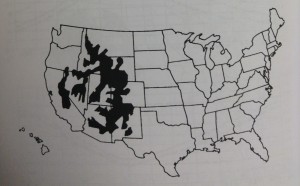
- Climate Priorities
- Keep the heat in and the cold air out during the winter (I)
- Let the winter sun in (III)
- Protect from the cold winter winds (II)
- Use thermal mass to reduce day-to-night temperature swings in the summer (VII)
- Starting at the 2/3 marker of August’s time frame until the first half of July it is considered the too cold zone (92%). The rest of the 8% goes to being in the comfort zones.
-
Climate Region 6–
In the coastal region of Washington state the climate is very mild, however in the winter the temperatures are cool and rain is common. Although the skies are frequently overcast, solar heating is still possible because of the small heating load created from the mild temperature fluctuations. There is a high RH level but it does not show significant problems because the it doesn’t coincide with the high summer temperatures. The climate region has large variations in micro climates because of the change in both elevation and distance from the coast, in some areas however the winter winds start to become a problem. And the summers are quite dry and sunny.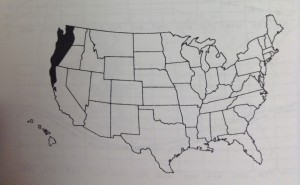
- Climate Priorities
- Keep the heat in and the cold temperatures out during the winter (I)
- Let the winter sun in (mostly diffused sun because of the clouds) (III)
- Protect from the cold winter winds (II)
- From the last 1/6 frame of August until first 1/16 time of June (79% of the year) is the regions too cold time. The rest of June and August (13%), the last 8% of the year (July) is the too hot zone.
-
Climate Region 7–
This regional climate winters are moderately cold, however winter sunshine is plentiful. Because of the low humidity during the hot and dry summer days it causes a large diurnal temperature range, but cool nights are common with rare chance of rain in the summer. Since the climates spring and fall are very comfortable periods and the rest of the year not so much, outdoor living is common. Around the coastal region the climate is moderate in both winter and summer, neither are dominant over the other.
- Climate Priorities
- During the winter keep the heat in and cold temperatures out (I)
- Keep hot temperatures out during the summer (VIII)
- Let the winter sun in (III)
- Protect from the summer sun (IV)
- Use thermal mass to reduce day-to-night temperature swings during the summer (VII)
- Use natural ventilation for cooling in the spring and fall (V)
- Use evaporative cooling in the summer (IX)
- Protect from the cold winter winds (III)
- From early October until late May the temperature is too cold (62%), Late May through the month of June and the month of September to early October are the comfortable periods (21%) of the year, and the month of July through August are the summer too hot periods (17%)
-
Climate Region 8–
Living in the mid-Atlantic-coast climate is relatively temperate, with very distinctive features of its regions seasons. Summer winds are valuable because its summers are very hot and humid, somewhat cold winters, and during spring and fall are quite pleasant. Summers however, are the wettest of the seasons because thunderstorms are common during that period.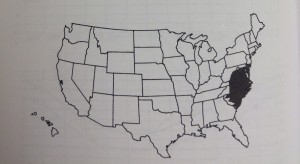
- Climate Priorities
- Keep the heat in and the cold temperatures out during the winter (I)
- Use natural ventilation for summer cooling (V)
- Let the winter sun in (III)
- Protect from the summer sun (IV)
- Protect from the cold winter winds (II)
- Avoid creating additional humidity during the summer (X)
- Late October through mid-April period (46%) of the year is the too cold zone, the rest of April and October (12%) are the comfort zones, and the too hot zone (42%) occurs between May through September.
-
Climate Region 9–
This climate is similar to that of region 8 but is more severe in the winter and the summer because its distance from the oceans. Winters are quite cold, with chilling winds from the northwest and summers are hot and humid, with winds often from the southwest.
- Climate Priorities
- Keep the heat in and cold temperatures out during the winter (I)
- Let the winter sun in (II)
- Use natural ventilation for summer cooling (V)
- Protect from the cold winter winds (II)
- Protect form the summer sun (IV)
- Avoid creating more humidity during the summers (X)
- From mid-October until md-April the temperature is too cold (52%), rest of April through half May and half of September through the rest of October are the comfortable temperature periods (13%), The rest of May through the first half of September are the uncomfortably hot periods (35%).
-
Climate Region 10–
Spring and fall of this region are mostly pleasant with a relative mild climate. Winters are cool with a chilling affect from the wind but are in the northern part of this region. Snow also has frequent occurrences at higher elevations in the southern part of the region. Summers are hot and somewhat humid; however the humidity is low enough to have a fair amount of night cooling to happen.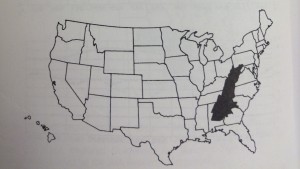
- Climate Priorities
- Keep the heat in and the cold temperatures out during the winter (I)
- Use natural ventilation for summer cooling (V)
- Let the winter sun in (III)
- Protect from the summer sun (IV)
- Protect from the cold winter winds (II)
- Avoid creating more humidity during the summers (X)
- Early October through Early May (56% of the year) the weather is too cold, early-May through early June and mid-September through mid-October (16%) are the comfort zone temperatures, and the rest of June through the rest of September are the too hot months of the year (28%).
-
Climate Region 11–
The climate of the Southwest desert region have extremely hot and dry summers and moderately cold winters. The skies are clear most of the year, with an annual sunshine of 85%. Since the summers are extremely hot and dry the diurnal temperature range is very large with nights that are often cool. The humidity is below the comfort range most of the year, affecting the design process concerns. April – June are the driest months of the year while August is the wettest.
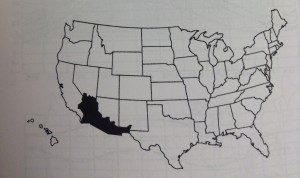 Climate Priorities
Climate Priorities
- Keep hot temperatures out during the summer (VIII)
- Protect from the summer sun (IV)
- Use evaporative cooling in the summer (IX)
- Use thermal mass to reduce day-to-night temperature swings during the summer (VII)
- Keep the heat in and the cold temperatures out during the winter (I)
- Let the winter sun in (III)
- Use natural ventilation to cool in the spring and fall (VI)
- Between November and mid-April are the too cold periods (48%), mid-April through the end of May and the end of September through October are the comfortable periods (15%), and at the end of May through most of September are the too hot months of the year.
-
Climate Region 12–
In the areas of west Texas and southeast New Mexico the climates are arid with hot summers and cool winters. There is plentiful sunshine, enough (60%) to supply ample solar heating in the winter. In this region the climatic design can have a very beneficial impact on thermal comfort.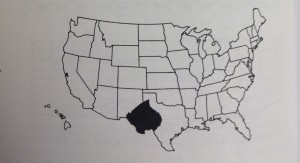
- Climate Priorities
- Use evaporative cooling in summer (IX)
- Let the winter sun in (III)
- Protect from the summer sun (IV)
- Keep the heat in and cold temperatures out during the winter (I)
- Keep the hot temperatures out during the summer (VIII)
- Protect from the cold winter winds (II)
- Use natural ventilation or summer cooling (V)
- Use thermal mass to reduce day -to-night temperature swings during the summer (VII)
- From October through April the region is its too cold zone (55%), May and September are the comfortable times of the year (19%), and June through August are the too hot time zones. (26%)
-
Climate Region 13–
In the areas of Oklahoma and northern Texas, during the winter you are likely to experience cold weather and hot summers with a northern cool breeze. During the cold winters, passive solar heating will still be available. During the hot summers the humidity will cause an uncomfortable feeling, but over the summer the humidity will drop enabling the effect of natural ventilation with a cool temperature.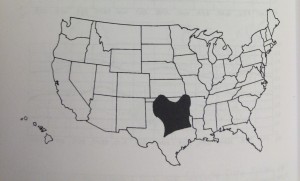
- Climate Priorities
- Use natural ventilation for cooling in spring and fall (V)
- Let the winter sun in (III)
- Protect from the summer sun (IV)
- Protect from the cold winter winds (II)
- Use thermal mass to reduce day –to-night temperature swings in the summer (VII)
- From the secon half of October through the first half of April (47%) is the too cold zone, the too hot climate zone it starts early- May through mid- September (39%), the rest of April, May, September, and October are the comfort zones of the climate during the year (14%).
-
Climate Region 14–
In the gulf coastal area of this region, it has cool but a shorter winter than the other regions. Summers are a much difficult time of the year: the summers are hot, very humid, and long on flat and damp ground (the frequent rainy days of this region causes the climate to be humid also increasing the chance of mildew). A small sea breeze is available during the day (strong), weaker at night, and nonexistent during the morning and evening because the wind changes its direction.
- Climate Priorities
- Allow natural ventilation to both cool and remove excess moisture in the summer (VI)
- Protect from the summer sun (IV)
- Avoid creating additional humidity during the summer (X)
- Let the winter sun in (III)
- Protect from the cold winter winds (II)
- November through February (36%) are the periods in the year of cold discomfort, late March and early October through the rest of the month are the periods of temperature comfort in the year, and late-March through early-October is the period of heat discomfort in the year (52% of the year)
-
Climate Region 15–
This regions climate is similar to region 14, but with a more severe summer, one will experience very high temperature and humidity levels. Having high humidity levels causes the temperature at night to remain stable (temperature not dropping), however that are frequent occurrences of a coastal breeze in the summer. Winters are short and mild with ample sunshine for winter heating needs; however the designer’s main concern is overheating in the summer.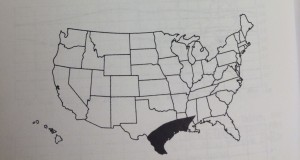
- Climate Priorities
- Keep hot temperatures out during the summer (VIII)
- Allow natural ventilation to both cool and remove excess moisture in the summer (VI)
- Protect from the summer sun (IV)
- Avoid creating additional humidity during the summer (X)
- Protect from the sum cod winter winds (II)
- Let the winter sun in (III)
- Keep the heat in and the cool temperatures out during the winter (I)
- In the time frame of December through March is the too cold zone during the year (34%), from late-April through early-November heat discomfort occur (54%), and the rest of April and November are the only comfortable times in the region (11%).
-
Climate Region 16–
This region mainly consist of southern Florida because of its different climatic conditions. Florida has long, hot summers and no winter. When the slightly high temperatures combine with the high humidity levels high heat discomfort will persist because of the summer temperatures. However because of its coastal region its climate has a beneficial wind from the ocean that causes year round comfort.
- Climate Priorities
- Open the building to the outdoors since temperatures are comfortable much of the year (XI)
- Protect from the summer sun (IV)
- Allow natural ventilation to both cool and remove excess moisture most of the year (VI)
- Avoid creating additional humidity (X)
- Keep the hot temperatures out during the summer (VIII)
- Keep the heat in and the cool temperatures out during the winter (I)
- Because of the long periods of summer feeling this region has low cold discomfort from January until early-March (11% of the year is too cold). Heat discomfort begins late-April and ends around late-November (69% of the year). The last 20% of the year in March, April, late-November, and December are the comfortable time periods of the year in southern Florida.
-
Climate Region 17–
The semiarid climate is very mild because of the almost constant cool winds from the ocean. Although these onshore winds bring high humidity, comfort is maintained because of the low temperatures. Occasionally when the wind reverses, hot desert air enters the region. Because this air is dry, comfort is still maintained. There is a sharp increase in temperature and a decrease in humidity as one leaves the coast. Winter temperatures are very moderate and little heating is required. The rain falls mainly in the winter, since there is almost no rain during the summer few plants can grow year round without irrigation. Since sunshine is plentiful all year, solar heating, especially for hot waters very advantageous.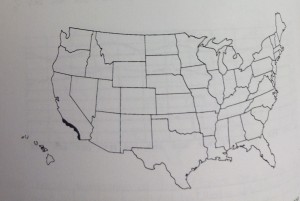
- Climate Priorities
- Open the building to the outdoors since temperatures are comfortable most of the year
- Protect from the summer sun
- Let the winter sun in
- Use natural ventilation for summer cooling
- Use thermal mass to reduce day-tonight- temperature swings in the summer
- From December to the first third of March is usually the “too cold” time period for the region (28%). From the rest of March through the end of July and from September to November are the comfortable temperature level in for this region it’s calculated to be 64% of the year. During the whole month of August the temperature level is averaged to be too hot (8%) of the year.
Resources:
“Heating, Cooling and Lighting 4th Edition” Lechner
